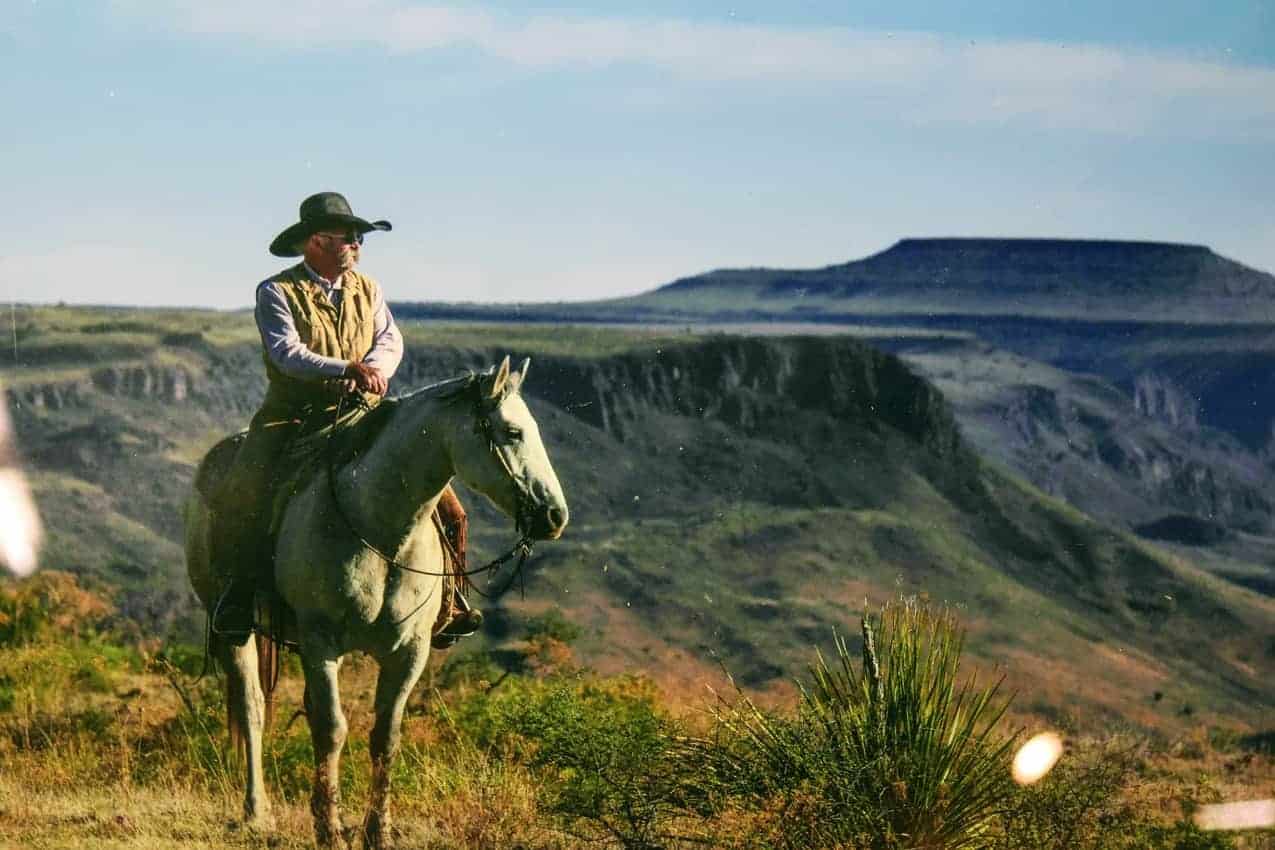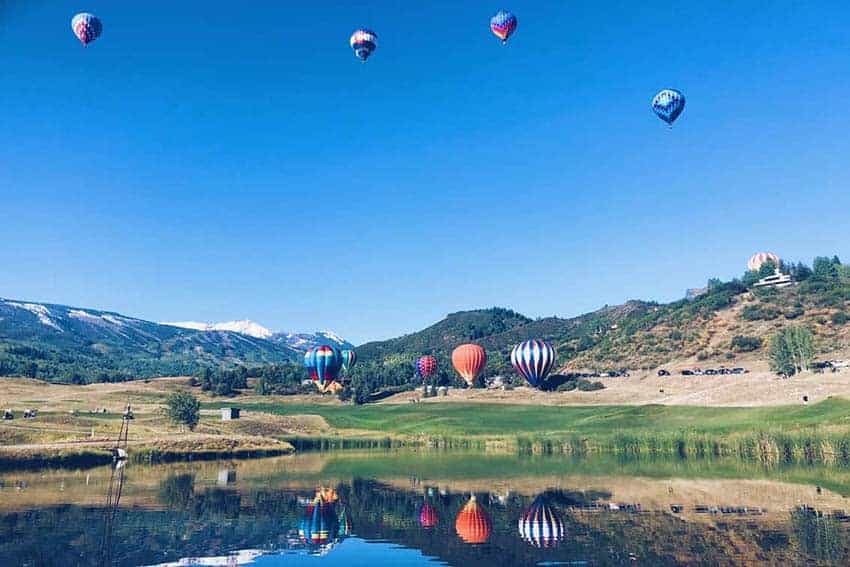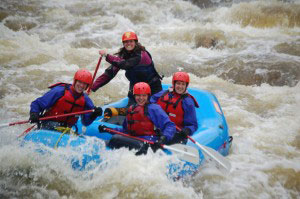
Cache La Poudre: The Real Taste of the Rockies
By Steve Flahive
I’d been advised to over-hydrate in preparation for the altitude. Heeding this advice paid dividends.
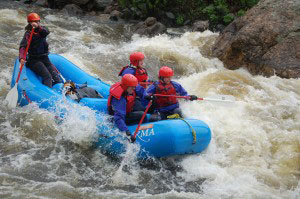
Not only was I clearheaded in spite of the altitude, but I had no trace of all the field research (beer sampling) I had assigned myself on the previous evening. This was fortunate because it was early morning and we were going whitewater rafting.
The Cache La Poudre (pronounced kash la POOH-dur) is Colorado’s only National Wild and Scenic river, and it begins at the peaks of Rocky Mountain National Park, flowing north and east along the Roosevelt National Forest, and eventually passes through Fort Collins.
The river, which owes its name to French-Canadian trappers who hid gunpowder in the river-valley during the raging blizzards of the early 1800s, is an absolutely prime candidate for travelers looking to go rafting on vacation.
The urge to be pummeled by river water in an inflated rubber boat is a desire one might naturally have, and it usually comes with a specific setting. As I envisioned the scene, our trip down the river was set against a backdrop of iconic and beautiful Colorado bluebird skies with the warm beaming sun. Happy to feel un-hungover for the big adventure, I yawned while walking to the window and drew the curtain back.
My head might have been clear, but the weather wasn’t. The unusual spat of rain that Colorado had been receiving persisted. Though it was June on the calendar, the dreary and raw day showed no evidence that summer might have plans to push spring out of the way anytime soon. It was cold.
The Few, The Cloud, No Sunscreen
Arriving at Rocky Mountain Adventures, none of us were terribly enthusiastic about donning wetsuits and hitting the rapids, and the empty parking lot told us we weren’t alone in feeling such sentiments.
All of the other reservations for the morning had disappeared overnight with the clear skies and we were the only holdouts.
Two in our own party had canceled, and nobody else showed up, so our trip down the Poudre was only four-strong. Me, Katy, Catie, and our guide, Mary, were the only ones in a raft that morning. I was not terribly surprised considering the weather. “Who wants to raft on a day like this?” I reasoned.
After the pro-forma signing-away of my right to sue in case of injury due to everything between bee stings and explosions, we got our wet suits. It was cold, and hypothermia didn’t seem out of the question (though, once on the river we realized hypothermia was, in fact, out of the question). Preparing for the cold meant we got the full head-to-toe treatment.
It was a tight fit, and below the knees, it was still damp. Additionally, the neoprene booties didn’t have much in the way of arch support. But, having signed off, stripped-down, geared up, safety-checked, and secured the raft behind our van, I was getting more excited. I was ready to paddle.

No Turning Back
Mary provided a rundown on rafting, her experience, the region, the river, politics of rafting tours, and Colorado history on the ride up. Like most people I’d met, she was an interstate-transplant; native Coloradans are both proud and rare.
Spotting what must have been a familiar landmark on the routine drive up, Mary looked over at the driver with an impish smile as we approached a cattle grate which spanned the width of the road.
Wordlessly, Mary jerked her arm across to the driver’s side and reached for the horn–pausing, with her hand hovered over the wheel, awaiting consent.
The driver smiled back, nodding approval, and Mary—instantly and eagerly—proceeded to blast a volley of honks at the road in front of the van. Satisfied, she then turned back towards us, beaming with a wide grin, and simply remarked: “To scare away the troll.” My confusion abated, I couldn’t help but smile too. Content that things were taken care of, I didn’t bother to ask what happens if they forget this step.
“She’s moving today”
The water was roiling and the river was fast. The numbered paint-line across a designated rock which rafting-guides use to gauge the river’s conditions measured just shy of 4. “She’s moving today” Mary affirmed, referring to the Poudre. “Almost Class 4.”
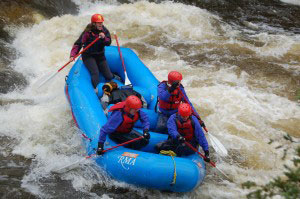
Class 1 is lazy-river and a cooler full of beer; class 6 means the section is either impassible or those who’ve tried are dead.
“I can do four” I thought to myself. My excitement and adrenaline rose in lockstep with the realization that the rain had plans to notch up the day’s ride and make it worth our while.
The conditions were almost a full tick higher than the Class 3 forecasted by the chalkboard behind the cash register at the RMA store.
Not all that Cold
Pushing off at a designated spot, we climbed aboard and Mary ran us through the commands which we’d mimed during the instructional primer. She gave more details about the instructions she’d be giving us and when we’d need to use them.
We were told that command of “all forward”—meaning we should paddle full-bore until told otherwise—would give us the power required to clear a hydraulic; our paddling would overcome the downward and upstream churn produced by water spilling over a rock and curling back upon itself. Paddling would keep us moving over the rapids that would otherwise stop us.
After allowing us a moment to figure out our “right”s from “left”s (important when one side is paddling opposite the other to quickly change the raft’s direction), we were off. By our first rapid, none of us could even tell it was raining anymore, though of course it still was.
As she explained the natural features—pointing out a rock formation which was called, and truly resembled, kissing gorillas, or providing the names of the rapids—Mary used the same congenial and unassuming tone as she had in the shop and on the van ride up.
Enter Stage Left: Mary’s Serious Side
When Mary needed paddlers, though, she flipped a switch and drained from her voice any hint that she was less than serious. If there was someone—herself included—that was talking, the raft-guide-Mary would interject using a tone of voice akin to what one might expect from a drill-sergeant.
This new Mary wasn’t mean or (entirely) intimidating; she was simply one-hundred-percent certain of what needed to happen at that exact moment, and unambiguously in control of getting her paddlers to make that thing—whatever it was—happen as it should.
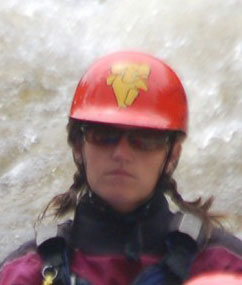
Hearing this voice, there was no question, no thinking: you better paddle, or get out of her boat. Even still, as soon as the hydraulics were cleared, the affable Mary rejoined the group to offer us, her paddlers, praise, and flattery because, as she explained, we really were doing a great job.
Occasionally, we’d go so far as to “high-five” paddles, which involved cheers-like motion–hitting the blades of our paddles above our heads–which was immediately followed by bringing them down and slapping the water as hard as physically possible.
Why the Guide Sits in the Back
Observing how she directed the boat’s approach as we neared each feature, I couldn’t help but feel she was simultaneously utilizing the skills familiar to a golfer (judging the off-angle stroke by reading pitch of the green and the lay of a putt), and a pool-shark (planning a follow-up shot two balls in advance by placing the cue-ball accordingly).
She knew that the turbulence under a certain bridge would pull left-to-right, so, approaching this section, Mary chose a bearing which had the raft hugging the left bank of the river in anticipation.
Hitting the current dead-on in its sweet-spot, we trolled between the stanchions without incident and then looked back at the segments which we avoided: as the water deflected forcefully off, and directly around, the bridge’s cement pilings, thick spinning eddies carved themselves into the hollow recesses of redirected water behind each column. It looked decidedly less pleasant than the route Mary took us.
Later, feeling we were up to it, she even directed us slowly through the meat of a hydraulic so we could feel the suction working against our forward motion. It was, in a word, awesome.
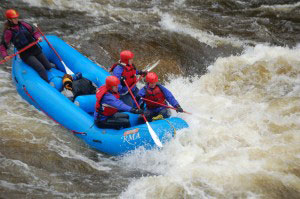
Back on Land
When we’d reached the end and flagged down the transportation at the designated spot, Catie, Katy and I were amped up. Though our smiles, which were intractably fixed upon our faces, didn’t fade away, standing on solid ground in the rain (which we once again took notice of) let the cold seep in.
After loading the raft on the trailer, and packing into the van, we departed with tight abs and warm tender shoulders. I’m sure I wasn’t the only one that felt ready to peel off the tight wet suit and wrap myself into a soft dry towel.
At the beginning of the day it made perfect sense that we would be the only ones on the river. “Who, but those on a deadline, would want to raft in weather like this?” I had reasoned.
Now, after trying it myself, I have a new question: “How could rain get in the way of doing THAT?”
Steve Flahive is a freelance travel writer and photographer from Boston.
Whitewater Rafting near Fort Collins, Colorado
Read Steve Flahive’s story about micro-hotels in New York
Airline Miles and Points: Going to Cooler Places for Less
Eurail Passes: What to Know about Buying a Europe Train Pass
- The Wild Mississippi: 2340 Miles Across Ten States - April 8, 2024
- Exploring the Floating Villages of Tonle’ Sap Lake - April 3, 2024
- Woman Traveling Solo on Turkish Buses - March 27, 2024




